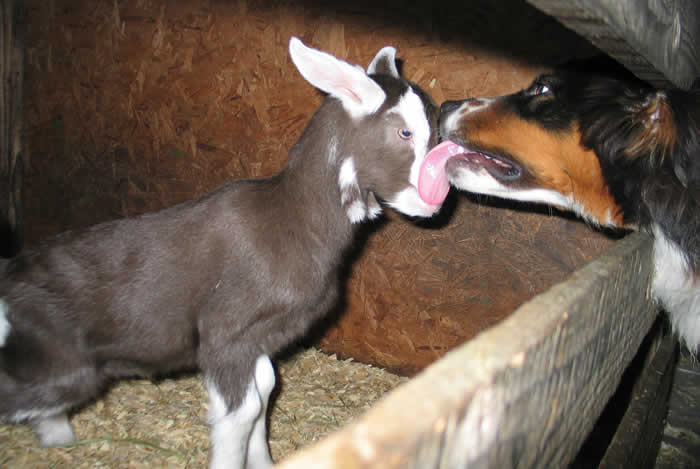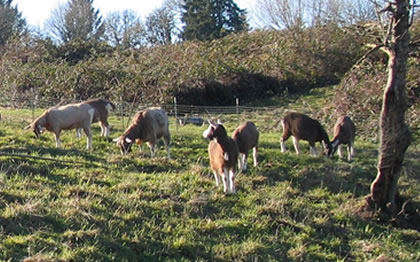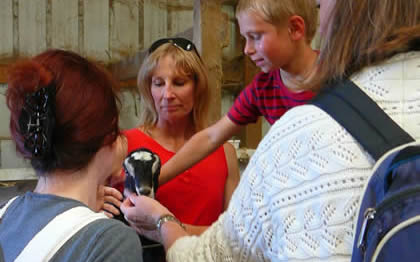Harlow Hills Farm
About our Dairy Goats

Our Goat herd and how we keep them healthy.
The goats were first purchased as brush eaters to keep the Himalayan Blackberries down. Toggenburgs were the chosen breed because of their small size, independent nature and uniform coloring. They did a great job and we fell in love with their sweet nature and carefree antics. The idea of having a commercial dairy grew as the blackberries died. Toggenburgs remained our chosen breed because of their great work ethic, quiet nature and obedience. You may be laughing now because who ever heard of a goat that stayed where it belonged and followed the routine so well that it made milking twice a day- every day- a pleasure, well that is a Toggenburg.
The Harlow Hills herd is a small herd. At our peak we were milking 28 girls and are currently down around a dozen. In 2012 we added La Manchas to the herd so we now have two breeds.
La Mancha’s were added because their milk has higher protein and butterfat. They are also a larger sized goat so we hope that with a few La Manchas contributing to the milk supply it will increase the herd average for milk protein and butterfat. Why is this important? The main thing that makes yogurt thick is the protein in the milk.
In the Toggenburg herd we are also breeding for increased protein and butterfat, in 2015 we used an outside buck- Birch Hollow Lilly’s Rob-Roy on most of our does. Rob-Roy has the Casein gene A/F so I am hopeful that we will get some Daughters with the A/F combination. Most Toggenburgs have the casein gene F/F. What does that mean you may ask? It means that their casein is less likely to cause you digestive upset if you are casein intolerant but it also means lower cheese yields and for us thinner yogurt. Once the kids are born we will have DNA tested to determine if any have this gene.
Our girls
In 2012 after the purchase of the 5 LaManchas that started our LaMancha herd we decided to “close” the herd. This means that we will not bring anymore new goats into the herd. This decision was made with the safety of our herd in mind. Every time we bought a new goat we risked introducing a disease or parasite to our herd and land. New genetics will still be used through AI and transporting our girls to outside bucks for breeding.
Parasites that are resistant to dewormers are an increasingly common problem around the world. In some parts of our country there are already worms that are resistant to all but the newest class of dewormers. We are fortunate that we are not yet at that stage. To prevent this from happening on our farm we are very careful with our deworming routine and use as many other deterrents as possible. Once a month we check the mucus membrane color on each goat, we are watching for pale coloration. If we see that one of the goats has gotten more pale since the last check we do a fecal egg count to determine if dewoming is necessary and which parasites to treat for. Our goats on average get dewomed once a year in late winter or early spring.
The way we feed our goats also helps prevent parasite problems. They get fed high quality Alfalfa year-round and grain formulated for dairy goats at milking time. This keeps them in good condition which is the first step in parasite prevention. In the spring and summer they also are rotated between 5 pastures for fresh feed. Most of these pastures are current mixed grasses and clover but we are switching them over to Chicory and Birdsfoot trefoil because the tannins in these plants discourage parasite growth and reproduction. The rotation between pastures give them a chance to re-grow (harder for the parasite larval stage to reach the part of the plant that is eaten) and there is some rest period which gives some of the larva a chance to die off. When we have the chance we also rotate another species of animal, –horses are the best- but we use calves, through the pasture behind the goats as some of the parasites are species specific.
Our herd is also on continuous milk test and appraised through ADGA’s Linear Appraisal system annually. Both of these tools help us to make breeding decisions and decide which animals to sell. The milk test lets us track how much each doe is producing, what her milk components are, and if her udder is healthy. The appraisal gives us a comparison of each goat’s conformation against an “ideal” goat. The score for each trait also gets put into a nationwide data base so that other goat breeders can “see” your goats through the appraiser’s eyes. This information helps immensely when trying to improve a trait.


